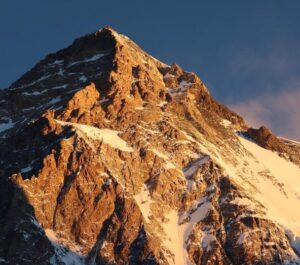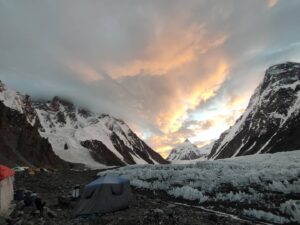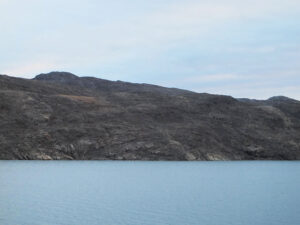Pakistan’s Karakorum is home to 108 peaks above 7,000m and four above 8,000m: K2, Gasherbrum I, Gasherbrum II and Broad Peak. (The country’s fifth 8,000’er, Nanga Parbat, is part of the Himalayan range.) Despite these riches, Pakistan remains much less visited than the Himalaya. Even K2, the second highest rock on earth, looms comparatively untouched. So what’s holding Pakistan back from a similar level of commercial success?
Lonely Planet calls Pakistan the “difficult child of South Asia”, a rather strange way to describe a nuclear power with a population approaching 200 million. The British Foreign Office advises against all but essential travel to most of the country, and against absolutely all travel to the federally administered tribal areas. This paints Pakistan less as an unruly child than a failed state.
However, these cautions have not deterred everyone. Tourism contributed 2.7% of Pakistan’s GDP in 2016, and K2 reliably draws climbers, no matter how far the country’s security status sinks down the global rankings.

Both British and Australian foreign office websites seek to deter their nationals from visiting Pakistan. Photo: Australian Foreign Office
Those international visitors who do come to Pakistan experience a very different country from the black domain of kidnappings, terrorist attacks and general hostility presented by western embassies. They describe a huge, vibrant country of stunning natural beauty, and a people that greet travellers with warmth and generosity. So which is it: Is Pakistan a too high a risk for foreign tourists to run? Or is it the victim of an international community that focuses unduly on its problems?

Famed adventurer Ned Gillette was killed by gunmen in northern Kashmir in 1998. Photo: Adventure-journal.com
It is hard to deny that when Pakistan makes the headlines, it’s rarely positive news. More typically, coverage focuses on drone strikes, terrorism and corruption. Its government has repeatedly been castigated for its unwillingness, or inability, to stem terrorism. Its porous border with Afghanistan remains a stronghold for a hodgepodge of terrorist groups, from traditional baddies such as the Taliban and Al-Qaeda to more obscure but no less hazardous entities such as Lashkar-e-Tayyiba and Jaish-e-Mohammed, operating out of Pakastani-administered Kashmir.
The Pakistani government undoubtedly has its hands full, juggling a battle against terrorism with public sentiment that is overwhelmingly anti-American and anti-Indian. Anything other than velvet-glove negotiations with the Afghan Taliban is particularly tricky, despite an ongoing fight with a home-grown Taliban insurgency.
For the most part, these issues are a world away for the climbing community, with terrorist attacks concentrated in southern Baluchistan and the eastern Federally-Administered Tribal Areas, rather than in the northern Karakorum. As Polish climber Aleksandra Dzik writes:
Before when we came to Pakistan, we got used to the terrorism in this country, where people unfortunately are killed every day. But we always felt that it didn’t concern us, that it was the problem of the Pakistanis and we were guests in their country. We believed that we were untouchable.
In 2013, this changed. That June, Taliban militants stormed the base camp at Nanga Parbat, murdering 10 climbers and a guide, in what may have been a botched kidnapping attempt. The attack sent shock waves through the adventure community. The area around Nanga Parbat, the Hunza Valley and Gilgit-Baltistan as a whole had felt safe. Now climbers were forced to re-evaluate their assumption.

Gilgit-Baltistan features jaw-dropping scenery but fragile safety. Photo: Raja Nazeem ul Amin
Thankfully, in the five years since the attack, the tragedy looks increasingly to have been an outlier. Expeditions have continued to visit the Karakorum, despite the complex bureaucracy involved in securing the necessary permits and climbing insurance. This year, at least 44 climbers are tackling K2, and every other 8,000m peak has foreign hopefuls on its slopes.
But despite Gilgit-Baltistan’s recent stability, terrorism in other areas of Pakistan is still a major issue. In 2017 alone, three major bombings snuffed out over 100 lives. While kidnappings have declined, two Chinese teachers were abducted in Quetta as recently as May, 2017. A month later, the Islamic State announced that it had executed them.
While the vast majority of visitors only experience the legendary hospitality of the Pakistani people, westerners must balance the allure of Pakistan’s comparatively untouched mountains with a security situation that can be described as consistently inconsistent. The Pakistani government is working hard to rebuild international trust by guarding the length of the Karakorum Highway and introducing special security details for those entering more remote areas. However, perceptions won’t change overnight, and for Pakistan to join Nepal as a commercial climbing Mecca will take a more than just a few years of stability.






